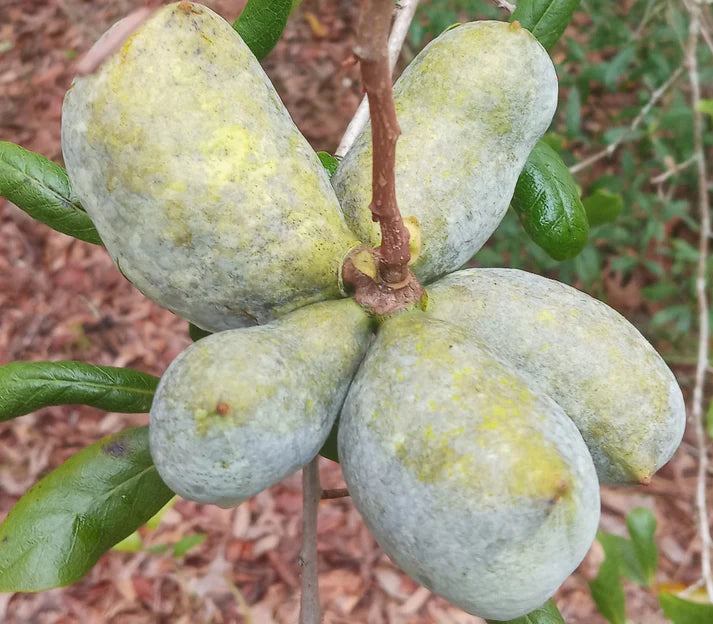Love it? Add to your wishlist
Your favorites, all in one place. Shop quickly and easily with the wishlist feature!
[message]
[title]
[message]



Veliyath Gardens
Couldn't load pickup availability
Flag Pawpaw Fruit Plant (Asimina Obovata): A Tropical Treasure with Health Benefits
The Flag Pawpaw (Asimina obovata), also known by names such as Big Flower Pawpaw, Scrub Pawpaw, and Papaw, is a unique member of the custard apple family. This exotic fruit plant, native to Florida and other subtropical regions of North America, stands out with its distinctive characteristics, sweet fruit, and medicinal potential. Whether you are looking to cultivate a fascinating plant in your garden or explore its health benefits, the Flag Pawpaw offers a rewarding experience.
Botanical and Common Names
General Information
The Flag Pawpaw is a shrub or small tree in the Annonaceae (custard apple) family. It is primarily native to Florida, where it thrives in open sandy hammocks and dry woods, making it an ideal plant for subtropical climates. This fruit-bearing plant features showy, white flowers that bloom from late winter to early summer, adding beauty to the landscape. Following the flowers, the plant produces large, green fruits that ripen to a custard-like, sweet flavor.
The fruit of the Flag Pawpaw is often likened to a custard apple due to its smooth, creamy texture and sweet taste, which is perfect for baking or making pie fillings. While the fruit falls early, it requires harvesting from the ground to fully ripen, providing a hands-on gardening experience. The Flag Pawpaw's unique flavor and texture make it a treat for both garden enthusiasts and culinary aficionados.
Nutritional Value
The Flag Pawpaw fruit is not just delicious but also nutritious, offering a variety of vitamins and minerals:
Although the nutritional content of the Flag Pawpaw is not as widely studied as other fruits, its sweet, custard-like flesh is a valuable addition to any tropical or subtropical diet.
Health Benefits and Medicinal Uses
Flag Pawpaw is not only known for its sweet fruit but also for its potential medicinal properties, which have sparked interest in both traditional and modern medicine. Here are some of the health benefits and uses of the Flag Pawpaw:
Acetogenins in the Plant: One of the key medicinal compounds found in the Flag Pawpaw’s twigs, bark, and leaves are acetogenins. These compounds are believed to have significant biological activity, particularly in cancer research. Acetogenins work by inhibiting the production of adenosine triphosphate (ATP), the primary source of energy for cells. By lowering ATP levels, acetogenins may help to slow the growth of certain types of tumor cells, although more research is needed to confirm these potential anti-cancer effects.
Head Lice Treatment: Pawpaw extracts have also been studied for their effectiveness in treating head lice. A small study demonstrated that a herbal shampoo containing pawpaw extracts successfully eliminated head lice and nits in a majority of participants. This indicates the potential of pawpaw as a natural remedy for this common issue.
Antioxidant and Antimicrobial Properties: Like many tropical fruits, Flag Pawpaw is believed to contain antioxidants that can help protect the body from free radical damage. Additionally, some studies suggest that pawpaw may have antimicrobial properties that help fight bacterial infections and promote overall wellness.
Environmental and Cultural Significance
The Flag Pawpaw is well-suited for subtropical climates, making it an excellent choice for gardeners in regions such as Florida, the Gulf Coast, and parts of California. The plant is adapted to sandy, well-drained soils and prefers partial shade to full sunlight. In the wild, it is found in open areas like hammocks and dry woods, where it thrives in low-maintenance environments. Its adaptability and hardy nature make it a sustainable plant for a variety of garden settings.
Culturally, the Flag Pawpaw is part of the rich heritage of native North American plants. In traditional folklore, pawpaws have been used for centuries for both culinary and medicinal purposes. The fruit’s unique taste and versatility have made it a staple in regional dishes, and its potential health benefits are now being explored in modern research.
Cultivation and Maintenance
The Flag Pawpaw is relatively low-maintenance, making it an appealing option for both novice and experienced gardeners. Here are some key points regarding the cultivation and care of this fascinating plant:
Environmental Impact and Sustainability
In addition to its culinary and medicinal uses, the Flag Pawpaw plays a role in local ecosystems. The plant serves as a source of food for native pollinators, and its fruits can attract wildlife such as birds and small mammals. The Flag Pawpaw’s ability to grow in sandy soils and subtropical conditions makes it an eco-friendly addition to gardens, especially those focused on sustainability and biodiversity.
By growing Flag Pawpaw, you contribute to the preservation of native plant species while enjoying a healthy and unique fruit. It is also a great choice for gardeners interested in cultivating a plant with both cultural and environmental significance.
Conclusion: Why Grow Flag Pawpaw?
The Flag Pawpaw is a remarkable plant that offers both beauty and function in the garden. From its stunning white flowers to its sweet, custard-like fruit, this exotic tree is a treat for the senses. Its potential health benefits, including its anti-cancer properties and use in treating head lice, make it an even more valuable addition to any garden.
For those in subtropical climates, the Flag Pawpaw is an excellent choice for quick fruit production, low maintenance, and a fascinating addition to your garden. With its rich cultural heritage and growing interest in its medicinal properties, the Flag Pawpaw is a plant that is both historically significant and highly beneficial for modern-day gardeners.
Maintenance Level: Moderate
Blooming & Fruiting Time: 3 to 4 years
Ideal for: Subtropical climates
Add the Flag Pawpaw to Your Garden Today – A Sweet, Nutritious, and Medicinal Fruit Awaiting Discovery!
Maintenance Level: Moderate. Flag Pawpaw trees require minimal pruning and care but do benefit from occasional fertilization, particularly in nutrient-poor soils. Regular watering is necessary.
Head Lice Treatment: Pawpaw extracts have also been studied for their effectiveness in treating head lice. A small study demonstrated that a herbal shampoo containing pawpaw extracts successfully eliminated head lice and nits in a majority of participants. This indicates the potential of pawpaw as a natural remedy for this common issue.
The fruit of the Flag Pawpaw is often likened to a custard apple due to its smooth, creamy texture and sweet taste, which is perfect for baking or making pie fillings. While the fruit falls early, it requires harvesting from the ground to fully ripen, providing a hands-on gardening experience.




